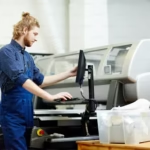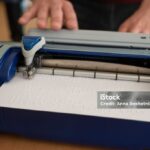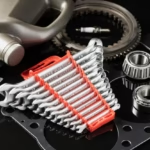Now Reading: Media Feed System for DTF Printing
-
01
Media Feed System for DTF Printing
Media Feed System for DTF Printing

There can be printed films with DTF techniques with a variety of applications. However, to get a high-quality output, an effective media feed system is fundamental. Hence, any drop in the quality of operation can lead to erroneous media film. This in turn leads to misalignment in the printer during the time of film feed. Such details about DTF media systems should be known to the operator to achieve a needed level of quality during the DTF.
The Role of the Media Feed System
The media feed system is crucial not only in the determination of the quality of the image printed out but also affects how efficient the whole process of printing is. A good feed system will increase the speed of production, cut the volume of waste, and reduce downtime. With the progress in DTF technology, the level of the media feed systems has also progressed, improving the feeding process by applying different technologies.
DTF Transfer vs. Screen Print Transfer: Which Method is Best for Your Custom Apparel?
Components of the Media Feed System
To appreciate the functionality of the media feed system, it’s essential to understand its key components:
1. Rollers
Rollers are the most essential elements of the media feeding system. These cylindrical parts hold the film and shuttle it through the printer. They are constructed in such a way that optimal tension is applied in such a manner that unwanted slippage but smooth motion is achieved. Different types of rollers are available in different materials and sizes, so they have to be made to suit the particular media. The material of the roller may vary the friction level which may in turn affect the quality of the prints.
2. Guides
Guides are important for preventing the film from losing its orientation with the printer whenever the film is moving through it. These are placed in locations along the feed path for the purpose of restricting the sideways movement of the film. Guides can be manually adjusted for different widths and thicknesses of media. When properly set, these safety ensure that the film is fed vertically which is important for uniform reproduction of quality.
3. Alignment Mechanisms
Alignment mechanisms are designed to keep the media in the correct position as it advances through the printing process. These systems can range from simple mechanical adjustments to sophisticated sensor-based systems. Sensors monitor the position of the film and make real-time adjustments to correct any misalignment, ensuring that the print remains sharp and accurate.
4. Tension Control
Proper tension on the media is necessary since consistent feeding requires it. Excessive tension can tear the film but insufficient tension can slip it. The adjustment of tensions on the media can be done manually or automatically depending on the operator’s choice and the properties of the media at hand.
5. Media Hold-Downs
Media hold-downs are extra parts which guarantee that the film remains flat when being printed. They stop media from lifting during the printing process which may result in loss of focus. These hold-downs get even more vital if intricate designs or lighter materials that are more inclined to movement are printed.
How It Works
Understanding the media feeding process can illuminate the importance of each component:
Step 1: Loading the Film
The process starts by placing the film on the feed rollers. The operators have to make certain that the film is correctly placed in relation to the feed path and that it is well gripped by the rollers. This first step is very important for preventing problems further in the printing process.
Step 2: Initial Calibration
Once the film is loaded, an initial calibration is performed by the media feed system. This is mainly concerned with the film alignment, but if it cannot be done correctly, the required alterations can be made. At this point, more sophisticated systems are fitted with sensors that automatically scan for and correct any asymmetries, establishing a neutral baseline for the succeeding printing stage.
Step 3: Advancing the Film
When the printing process starts, the rollers start functioning to push through the film across the printer. These rollers are mechanically adjusted to the speed of the printer, allowing the film to be drawn at a constant speed. Such synchronization is important since it is essential if one wants to achieve uninterrupted good-quality prints.
Step 4: Continuous Monitoring
The sensors automatically control the position of the film and keep it in place. If any dislocation occurs, the system is capable of executing immediate corrections and ensuring that the media stays on track. This continuous loop of information is crucial for the quality of the print operations, especially of highly detailed designs.
Step 5: Ejection of the Finished Print
The printing process involves media that has been installed into the printer and once this procedure is professionally executed, the media is ejected without any disturbances. It can also be noted that proper ejection mechanisms are put in place so that the finished print is not damaged while being removed. Henceforth, the film can be cured or go through heat transfer depending on the particular DTF workflow being used.
Common Issues and Solutions
There can, however, be some challenges to a justified media feed system, regardless of how well it has been designed. This article focuses on several of the problems that are typical to DTF printing and possible solutions to these problems:
1. Media Slippage
Issue: In case the rollers do not grip the film appropriately, there is the likelihood of slippage during printing.
Solution: Routinely check the rollers for dust and damage. Also, check if the rollers are tensioned enough to hold the film tightly. If the slippage persists, consider modifying the density or roughness of the roller.
2. Misalignment
Issue: Skewed prints often result from misalignment during the feeding process.
Solution: Check the alignment guides for any damage or misplacement. Recalibrating the system may be necessary. Implementing automatic alignment sensors can also significantly reduce the likelihood of misalignment issues.
3. Jamming
Issue: Media jams can occur due to obstructions in the feed path or malfunctioning components.
Solution: Conduct regular maintenance checks to clear any debris from the feed path. Inspect all components, including rollers and guides, for wear and tear. Implementing a preventive maintenance schedule can help minimize the risk of jamming.
4. Inconsistent Print Quality
Issue: Variations in print quality can result from uneven feeding or incorrect tension settings.
Solution: Monitor the tension control settings and make adjustments as needed. Ensure that the media is compatible with the printer specifications to achieve consistent results. Regularly calibrate the printer and media feed system to maintain optimal performance.
5. Material Compatibility
Issue: Different media types may require specific handling and feeding techniques.
Solution: Always check compatibility between the media and the feed system. Adjust settings, such as roller pressure and tension, based on the characteristics of the media being used. Using the right feed components designed for specific materials can enhance performance.
Conclusion
For ensuring quality output from DTF printers and Ultimate pc23 DTF inks, consideration must be paid to the reliability of the media feed system which is the most essential. There is at least one more objective that underlines its significance in design: the productivity, stability, and efficiency of the printing process as a whole. Familiarisation of personnel with components of the media feed system, functioning processes, and possible hindrances to the functioning make them responsible for uninterrupted operation.
Investing in a well-engineered media feed system not only enhances print quality but also boosts productivity and reduces operational costs. As DTF technology continues to evolve, staying informed about advancements in media feeding techniques and systems will be essential for maintaining a competitive edge in the printing industry. A robust media feed system is, without a doubt, a vital investment for anyone serious about DTF printing success.



































